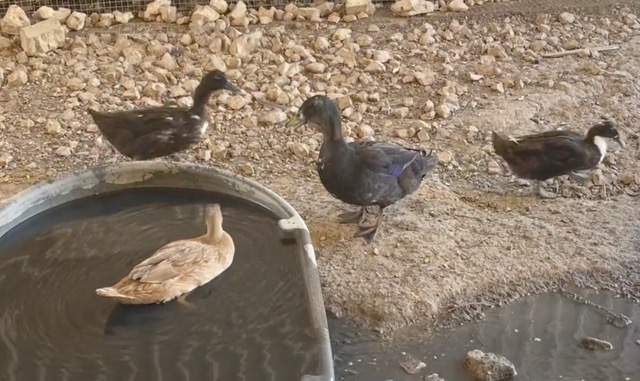The ducks at LGRS (Lucky Glider Rescue and Sanctuary) are so fun to watch. When we built the aviary, we were sure to add stock tanks for them to paddle about in. We also routinely flood one part of their enclosure with water. Why? Well, not only do ducks enjoy water, but they doubly enjoy drilling into the mud.
You can observe ducks jamming their bills into the mud and a lot of folks think they are actually eating the mud. They are not really eating the mud. Instead, they are using their bills to sift the mud in a search for edible bugs or plant material.
What’s interesting is after we feed them the good stuff (a mixture scratch grains, protein crumble, cabbage, and cantaloupe), they will eat some of that but five minutes later make a bee-line for the mud so they can drill. I reckon it’s just part of their DNA that they gotta drill!
We have both Cayuga and Khaki Campbell ducks. The Khaki Campbell (brown ones) are kind of famous because of a Thai tradition in which ducks are used to clean recently harvested rice paddies.
There’s a great video on YouTube that describes this. It features a Thai duck producer who releases 10,000 ducks for a few months on the rice paddies to eat snails and left-over rice husks. They call it “ped lai thoong” which translates to “field-chasing ducks.” They use the ducks to “clean” the paddies which is apparently a big tradition in Thailand. For the duck producer, the benefit is they don’t have to feed the ducks until they mature, because there are plenty of bugs and snails to eat in the rice stubble. For the rice farmer, the benefit is a reduced need for pesticides and other chemicals. And amazingly, the ducks make it easier for the farmers to plough the land for the new plantings because the ducks flatten out the ground as they move along. It’s a win-win for both duck producer and rice farmer. This gargantuan raft of ducks is corralled, loaded up ramps onto trucks, then transported to different rice fields in the area.
In the wild, ducks will eat seeds, pond weeds, frogs, tadpoles, crustaceans, and of course, as the famous ones in Thailand – snails.

